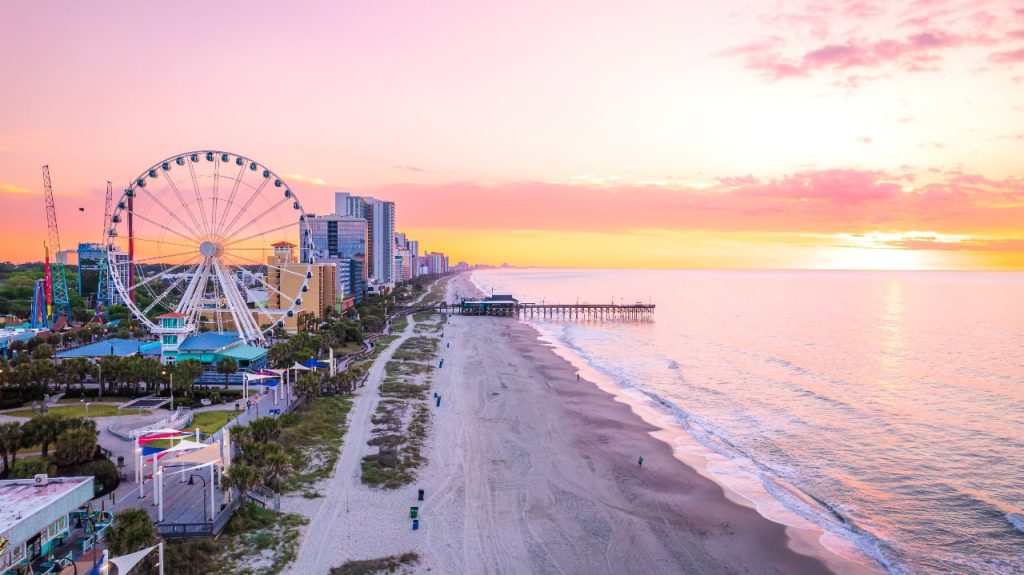Myrtle Beach, a well-known coastal destination in South Carolina, is responding to recent claims labeling it as the second most dangerous beach in the United States, following a controversial study by Everly Life. This report has sparked significant local backlash as residents and city officials contend that the findings are misleading. Heightened concerns about safety have emerged, particularly after a mass shooting incident in April, but officials emphasize that this is an anomaly rather than a reflection of the area’s true safety.
| Article Subheadings |
|---|
| 1) Overview of the Safety Ranking |
| 2) The Methodology Behind the Study |
| 3) Local Reaction to the Ranking |
| 4) Impacts of Recent Violence |
| 5) A Community Perspective |
Overview of the Safety Ranking
The recent study by Everly Life, which identified Myrtle Beach as the second most unsafe beach in the U.S., has drawn considerable attention and controversy. The ranking is largely dominated by beaches in Florida, with New Smyrna Beach topping the list as the most dangerous beach. Other locations such as Miami Beach, Jacksonville Beach, and Oak Island in North Carolina also made an appearance in the study. Local officials and residents have voiced their concerns about the credibility of such rankings, arguing that they don’t accurately reflect the reality of Myrtle Beach as a tourist destination.
The Methodology Behind the Study
The study’s authors evaluated several factors to gauge the safety of beaches, primarily focusing on crime rates, shark attacks, drownings, and wind conditions. However, the choice of data sources has raised eyebrows among critics. It remains ambiguous why no beaches from the West Coast or Northeast were included in the study, prompting questions about the dataset’s comprehensiveness. In an age where accurate data is crucial, the lack of transparency regarding the parameters used has fueled skepticism among residents and city officials alike.
Local Reaction to the Ranking
Following the release of the study, a wave of criticism emerged from Myrtle Beach’s community leaders. Meredith Denari, the director of communications for the City of Myrtle Beach, condemned the findings as “misleading, flawed and clearly skewed.” She criticized the methodology for utilizing outdated statistics, including shark attack records dating as far back as 1882, along with crime data that was not reflective of the current year. In her statement, she emphasized the need for more accurate and relevant data when discussing public safety. “I would call this study ‘fake news,’” stated Denari, underlining her frustrations with the portrayal of Myrtle Beach’s safety.
Impacts of Recent Violence
Compounding the issue of safety is the recent mass shooting incident that occurred on April 26 in a popular entertainment district. This tragic event left one person dead and 11 others injured, leading local officials to describe it as an isolated incident. Despite this occurrence, many residents argue that such violence is not reflective of the broader community. Denari noted that Myrtle Beach’s police department has reported a downward trend in crime statistics, and ongoing revitalization efforts are already underway. The isolated nature of this shooting has raised further questions about the applicability of the safety rankings to Myrtle Beach as a whole.
A Community Perspective
For many residents of Myrtle Beach, the portrayal of their city as unsafe is both inaccurate and frustrating. Local resident Melissa K., who has lived in the area for seven years, expressed her feelings of safety and community vibrancy. Despite the recent shooting, she believes that incidents of this severity are rare and emphasized the importance of being aware of one’s surroundings, a sentiment echoed by many locals. “It’s a beautiful place to visit and hang out at the beach,” she remarked, asserting that safety is much more complex than a surface-level ranking can convey. Melissa highlighted that tourists, especially those venturing out late at night, often congregate in areas more prone to rowdy behavior, prompting residents to avoid those locales. However, the overwhelming beauty and allure of Myrtle Beach continue to attract visitors year after year.
| No. | Key Points |
|---|---|
| 1 | Myrtle Beach is ranked as the second most unsafe beach in the U.S. by Everly Life. |
| 2 | The ranking methodology has been criticized for using outdated and irrelevant data. |
| 3 | City officials described the study as misleading and “fake news.” |
| 4 | A recent mass shooting raised concerns about safety but was labeled an isolated incident by officials. |
| 5 | Local residents maintain a sense of safety and community despite external perceptions. |
Summary
The safety ranking of Myrtle Beach, specifically labeling it as the second most dangerous beach in the U.S., raises significant questions about the methodology used in such studies. Local officials argue the findings misrepresent the area, especially in light of an isolated mass shooting incident that does not reflect the broader safety trends in the community. Residents continue to express their pride in Myrtle Beach as a safe and welcoming place, countering external perceptions with their lived experiences. The city asserts that it remains committed to maintaining and improving safety, while also promoting its vibrant tourism sector.
Frequently Asked Questions
Question: What factors did the study consider when ranking beaches?
The study evaluated several risk factors including crime rates, shark attacks, drowning incidents, and wind conditions to determine the relative danger of beaches.
Question: How has the local community reacted to the safety ranking?
Local officials and residents have criticized the ranking as misleading, arguing that it does not accurately reflect the safety and vibrancy of Myrtle Beach.
Question: What incident heightened safety concerns in Myrtle Beach?
A mass shooting incident on April 26, which resulted in one death and eleven injuries, has raised concerns about safety but was described by officials as an isolated event.


